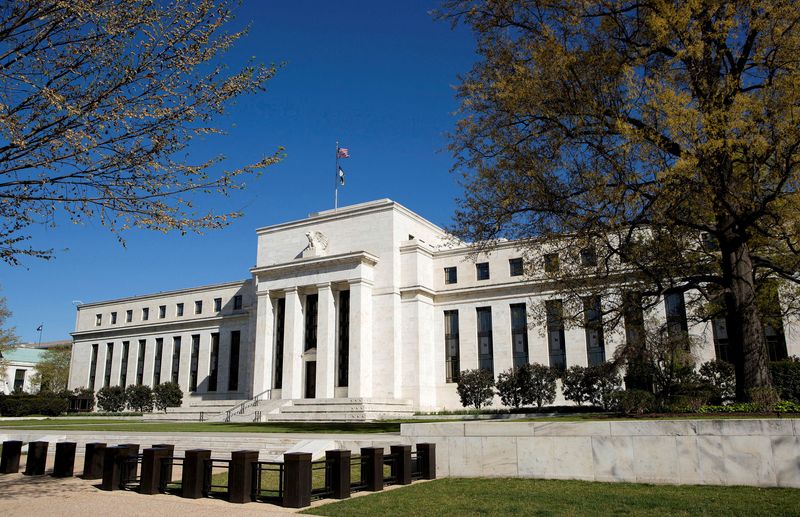By Howard Schneider
WASHINGTON (Reuters) - Federal Reserve Chair Jerome Powell says the central bank is not growing more tolerant of higher inflation even though the latest policymaker projections raised the inflation outlook for the year without triggering a tougher monetary-policy response.
But former Fed officials and other analysts see Powell nevertheless approaching a difficult moment trying to reconcile competing economic risks, a divided group of Fed policymakers, and a public now expecting interest rate cuts to start in June.
Upcoming data may well support a June rate reduction if inflation declines convincingly towards the Fed's 2% target between now and then, resuming a trend that encouraged policymakers last year to cap the federal funds rate at the current 5.25%-5.50% and lay the groundwork for easing to begin this year. Others see a slowing economy and weakening job growth on the horizon, pushing the Fed to cut in order to support the labor market.
Yet even if inflation proves more persistent than expected in coming weeks and the economy remains strong, the Fed could still proceed with a June cut by framing it as a potentially one-off adjustment rather than the locked-in beginning of a series of reductions, former Fed Vice Chair Richard Clarida, now a global economic adviser to bond giant PIMCO, wrote this week in assessing the pivotal moment central banks face in their policy communications.
The upfront justification of rate cuts expected to start this summer, Clarida said, would be that policymakers are simply keeping rates in step with the decline in inflation seen since last year, and could cut further as long as inflation continued to fall.
But "if inflation...does not follow the forecasts and becomes entrenched at a plausible 2.5%...the central banks would likely pause their rate cut cycles," Clarida wrote, and depend "on their belief that by keeping policy restrictive long enough, they can credibly forecast inflation returning (eventually) to the 2% target."
An initial cut, explained with language that tilts towards suspending further reductions if inflation does not behave as expected, would hedge the risks facing both sides of the Fed's employment and inflation goals, and assuage the concerns of Fed officials worried most about damaging the current expansion as well as those worried most about embedded inflation.
'SOMETIMES BUMPY'
It would also throw a kink into expectations that 2024 will be the year when the Fed's record-setting inflation battle ends in a steady succession of rate cuts and continued economic growth.
Recent comments from Fed officials have put divergent views on display, with Fed Governor Christopher Waller saying Wednesday he would support keeping policy tighter than expected if inflation data is not encouraging, and Chicago Fed President Austan Goolsbee saying earlier in the week recent high inflation readings don't undercut the trend towards easing price pressures.
Powell will update his views in an appearance Friday at the San Francisco Fed that will follow the release of new inflation data for February.
At his press conference after last week's policy meeting, he said recent, more elevated price data "haven't really changed the overall story, which is that of inflation moving down gradually on a sometimes-bumpy road toward 2%," comments that left expectations for a June rate cut intact.
Part of that narrative appears driven by policymakers' belief the economy is in a rare moment when the forces that can sometimes disrupt central bankers' best laid plans have been working in the Fed's favor.
Productivity has been growing at a surprising clip, allowing the economy to grow fast without adding to price pressures; a jump in the labor force has also helped the unemployment rate stay low without driving up wages. The Fed's most recent set of economic projections continued that rosy view of the world, with faster economic growth and a slightly lower unemployment rate than anticipated as of December, and inflation still falling to the 2% target over the next two years though at a slightly slower pace.
'NOISE'
Skepticism about that view is likely to grow, however, if Friday's data and other incoming inflation figures are higher than anticipated - and not just from steady inflation hawks like Waller but from others as well, like Atlanta Fed President Raphael Bostic, a voter this year on interest rate policy.
In comments to reporters last week, Bostic said he had already scaled back his expectations for 2024 from a half-point reduction in the policy rate to a quarter point cut, "and I'm looking sort of later in the year than I might have not otherwise" to approve it.
Upcoming inflation and economic data could well sway policymakers in either direction.
Recent projections showed a group that was sharply divided. While the baseline remained intact at three quarter-point rate cuts this year, the split was 10 to 9 between those policymakers seeing at least that many, and those seeing less easing ahead.
But they were also tightly clustered. With 14 of 19 officials seeing either two or three rate cuts this year, the consensus view could easily shift.
In an analysis for Evercore ISI using methods employed by Fed staff, former top Fed economist John Roberts wrote this week the outlook at this point hinges on whether policymakers dismiss the high inflation readings of January and February as "noise," or as evidence price pressures are receding more slowly - with the one view arguing for three or perhaps even four rate cuts this year, and the other only two.

At this point, he said, faith in disinflation, driven by a sense the economy can grow more without higher prices, appears to be trumping a more hawkish view of the world.
The core of policymakers "appears to be treating the bad news on inflation in January and February as a one-off," Roberts wrote, an interpretation consistent with both an optimistic view of the economy and easier policy ahead.